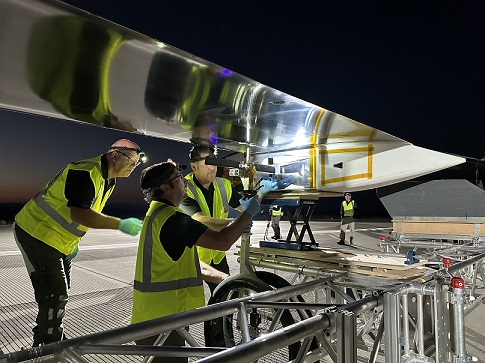The first stratospheric flight trial has taken place for a UK unmanned aerial system from defence specialist, BAE Systems
British engineers have successfully completed a stratospheric flight trial of BAE Systems’ High Altitude Pseudo Satellite (HAPS) Uncrewed Aerial System (UAS) – PHASA-35.
Over a 24-hour period, PHASA-35 soared to more than 66,000 feet, reaching the stratosphere, before landing successfully. The trial, completed during June in New Mexico in the USA, allowed engineers to assess the performance of the experimental solar-electric drone within the outer-reaches of the planet’s atmosphere.
The flight marks a significant milestone in PHASA-35’s development which began in 2018. Designed by BAE Systems’ subsidiary Prismatic Ltd to operate above the weather and conventional air traffic, it has the potential to provide a persistent and stable platform for various uses including ultra-long endurance intelligence, surveillance and reconnaissance, as well as security.
It also has the potential to be used in the delivery of communications networks including 4G and 5G and could be used in a wide range of applications, such as disaster relief and border protection, as an alternative to traditional airborne and satellite systems.
The PHASA-35 programme sits within FalconWorks, a new centre for advanced and agile research and development within BAE Systems’ Air sector, designed to deliver a range of cutting-edge combat air capabilities to the UK and its allies.
PHASA-35, which has a 35-metre wingspan and carries a 15kg payload, uses a range of advanced technologies including composite structures, energy management, solar electric cells and photo-voltaic arrays to provide energy during the day which is stored in rechargeable cells to maintain flight overnight.
The successful trial assessed the performance of the experimental system across a range of areas. It is the first in a series of trials planned to confirm system performance, support development activities and validate test points to enable PHASA-35 to be made available in defence and commercial markets internationally.
According to Dave Corfield, CEO of Prismatic Ltd, the successful completion of the test flight is a fantastic achievement for everyone involved and shows the commitment of BAE Systems to invest in new technologies and markets. PHASA-35’s first stratospheric flight demonstrates that this vehicle is on track to become a desirable system for long endurance, high altitude and communications applications in the future, he believes.
“The successful trials are a testament to the hard work of the fantastic team that we have built over the last couple of years within Prismatic and across our partner companies including Piran, Amprius, Microlink, Honeywell, PMW Dynamics and the Met Office. I look forward to the next steps as we develop this unique system,” he says.
Cliff Robson, Group Managing Director for BAE Systems’ Air Sector continued by saying that PHASA-35 is breaking new ground – opening up the stratosphere to new possibilities.
“The team, which brings together BAE Systems’ know-how from across the globe with innovative solar and power management technologies, demonstrated tremendous commitment and ambition as they tackled the challenges associated with novel technologies and approaches. This partnership approach is key to our ability to enhance our defence expertise with new thinking and technologies.”
The latest trials took place from Spaceport America in New Mexico, flying in the White Sands Missile Range, and are sponsored by the US Army Space and Missile Defence Command Technical Centre. This test flight at White Sands Missile Range was coordinated and directly supported by personnel attached to Naval Surface Warfare Centre, Port Hueneme Division, Detachment White Sands.
Support For UK Jobs and Economy
Research carried out by Oxford Economics shows the extent of BAE Systems’ contribution to the UK economy, including creating highly skilled jobs, funding world-leading research and sustaining a vibrant national supply chain.
The company is delivering some of the world’s most advanced defence programmes, from Dreadnought submarines to next-generation combat air systems. This critical work relies on the skill, expertise and dedication of employees, contractors, trade unions and suppliers across the country.
Last year, BAE Systems’ operations contributed £11 billion to GDP – equivalent to 0.4% of the domestic economy.
Charles Woodburn, BAE Systems Chief Executive, said: “As one of the UK’s largest employers, we recognise our responsibility to help deliver economic prosperity and so our continued investment in skills, technology and the communities where we live and work supports thousands of jobs and is creating opportunities for people.”
In 2022, BAE Systems directly employed almost 40,000 people, supported a further 49,000 jobs across the supply chain and thousands more in local communities.
Almost 40% of BAE Systems employees are based in the UK’s most deprived areas, where long-term employment opportunities are crucial for local economies to grow. Last year, the Company spent £730 million with suppliers in these locations out of £3.9 billion with around 6,000 suppliers in 2022, bringing investment and employment to every part of the UK from the Scottish Highlands to the Isle of Wight.
Nearly three-quarters of BAE Systems’ employees work in engineering-related roles. To maintain this pipeline of talent, the Company spent £180 million on education and skills last year, almost doubling its annual investment since the previous year.
As well as supporting educational outreach in its communities, this investment allows BAE Systems to provide lifelong development for its workforce and helps give its more than 4,300 apprentices and graduates the best start to their careers.
- UK manufacturing steps up to COVID-19 crisis - April 2, 2020
- Clustering Innovation - March 12, 2020
- A Global Monitor - March 6, 2020

